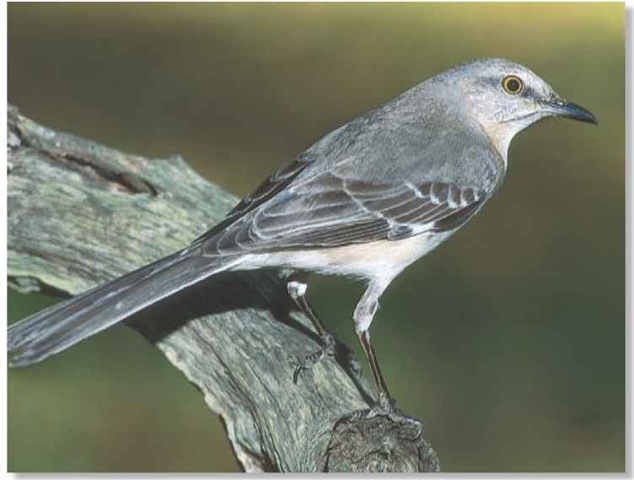ORDER
Passeriformes
FAMILY
Mimidae
GENUS & SPECIES
KEY FEATURES
Mimics about 30 different species of bird and a variety of other sounds, from whistles to barks
Boldly defends a wide territory but reduces its area size in winter
Eats fruits and insects; devours a large number of harmful crop pests
WHERE IN THE WORLD!
Widely distributed throughout North America, from Alberta and Quebec in Canada south to Mexico and the Bahamas
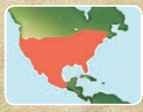
Lifecycle
The northern mockingbird, a master mocker, deceives hunters and birdwatchers with its song imitations, and battles intruders in mock fights and pecking matches.
HABITAT
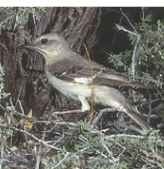
Found throughout North America, northern mockingbirds in the northernmost areas migrate south for the winter. But in the rest of its range, the mockingbird sets up permanent residence in a variety of open habitats. From lawns and farms to gardens and pastures, the northern mockingbird is found wherever there is an attractive mix of trees, shrubs and grasses. This blend of vegetation provides food and protection for the mockingbird. Year-round homes include streamside thickets and schoolyards in the north, orchards and vineyards in the west and even cactuses in the southwest. The mockingbird has even been introduced and is a year-round resident in Hawaii. In the winter, the bird stakes out and boldly defends a small territory centered around a food source. But with the start of the breeding season in January, the male mockingbird establishes a much larger nesting territory in preparation for starting a new family.
A Out of the way
The cup-shaped tree nest conceals the newborns.
Name that tune
A juvenile tries out a new limitation at its tree perch.
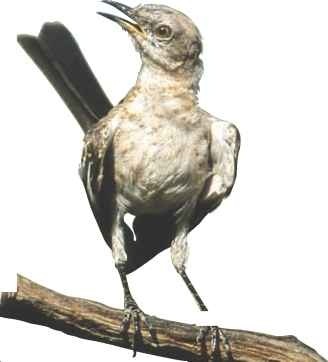
BREEDING
The male signals the start of the breeding season with a loud, brash call. When a female enters its territory, the two birds watch each other and communicate with a loud series of calls. Once a pair bonds, the frequency of their songs decrease. The birds work quickly to construct a strong, cup-shaped nest of twigs, grasses and rootlets about 3-10′ above ground. The female lays up to six eggs and begins incubating after laying the last one. The hatchlings are fed by both parents for about 12 days and then fly off to establish a territory of their own. More than one brood can be raised during the breeding season.
A hungry trio
With mouths open, young hatchlings resemble bright yellow flowers.
BEHAVIOR
The mockingbird has an uncanny ability to mimic at least 30 other birds’ songs. The imitations are incredibly precise. For example, the red-winged blackbird can’t tell for sure if a song is from a fellow blackbird, indicating that the territory is already claimed. This mimicking helps keep other species out of the mockingbird’s territory. When establishing its domain, the mockingbird loudly repeats a note at least three times, then switches to another phrase or imitation. The mockingbird’s repertoire is not limited to bird songs. It can imitate the tinkling of a piano, squeaky hinges and even a dog’s bark. When its songs don’t warn off trespassers, its aggressiveness is a quick deterrent. Dogs, cats and squirrels are savagely pecked. Mockingbirds can be harsh with other birds as well; it assumes a threatening posture, with tail cocked and fanned, against robins, starlings and woodpeckers that dare try to rob from its area.
COMBAT ZONES
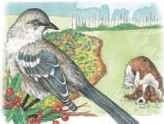
Backyard guard…
The mockingbird maintains its breeding territory with an ever-changing song. It scans for intruders from its treetop perch.

Battle-scarred…
The bird considers the suburban garden as its domain. It swoops down for attack and pecks madly at the unwelcome resident dog.
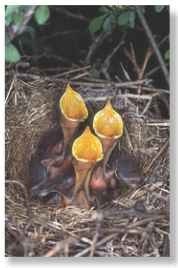
Chosen for its singing abilities or territorial allegiance, the mockingbird is the state bird for Arkansas, Florida, Texas, Mississippi and Tennessee.
In the Pueblo culture, it is believed that the mockingbird grants the gift of speech to humans.
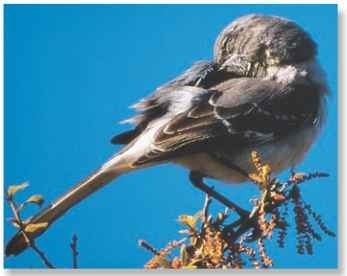
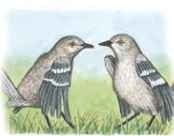
Rite of spring…
Boundary disputes occur between March and August when males confront each other at the edge of the breeding territory.
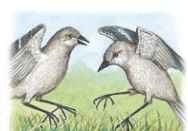
Boxing ring
They look like boxers at the start of a match, but only hop along a disputed border until the intruder retreats in defeat.
FOOD & FEEDING

A bittersweet feast
Berries and fruits are the staples of the northern mockingbird’s diet.
The northern mockingbird eats a variety of fruits and insects. Domestic fruits such as grapes, oranges, blackberries and figs account for a portion of the bird’s diet, but wild fruits such as holly, smilax, elderberry, mulberry and fruit of the prickly pear cactus account for about 45% of the total food eaten. Almost half of its daily diet is insects, including harmful crop pests such as boll weevils, cucumber beetles and chinch bugs. Grasshoppers, caterpillars, spiders, sow bugs and snails round out the high-protein portion of the mockingbird’s meal. The bird pounces on bugs from its perch with a swift descent, often catching an insect in midair above a tangle of wildflowers. The mockingbird also takes advantage of food such as bread, raisins or suet (hard beef fat) left out by humans.This easy snack is welcome, especially during the cooler winter months, when food is scarce in northern regions where birds remain year-round.
CONSERVATION
The northern mockingbird’s affinity for crops of sweet fruits and berries may put it in jeopardy. One grape grower killed 1,100 mockingbirds to keep them from eating portions of his valuable crop. But the northern mockingbird has adapted well to urbanization of its natural habitat, and populations remain strong. Habitats modified by open tree and shrub plantings simulate the natural forest-edge conditions preferred by the mockingbird and have led to its spread across the United States. The push northward has been slowed by destruction of similar woody habitats.
PROFILE
Northern Mockingbird
Despite its dull plumage, the northern mockingbird attracts attention with its mimicking medleys and daredevil territorial defense tactics.
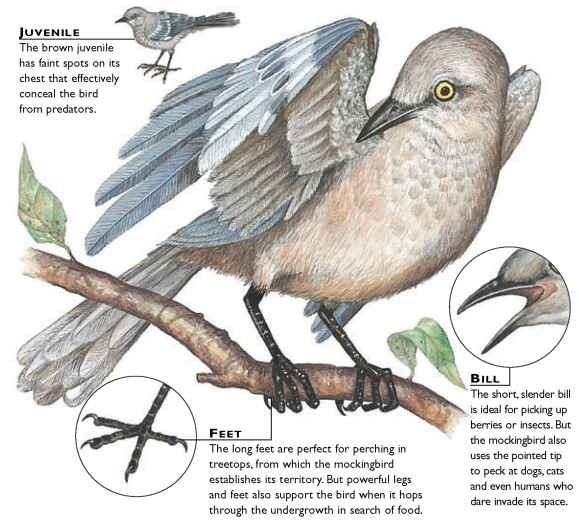
CREATURE COMPARISONS
The 10″ long Galapagos mockingbird (Nesomir is comparable in size to the northern mocking Galapagos mockingbird, as its name suggests, is only on the Galapagos Islands of Santa Fe, Isab Fernandina and Darwin.There, they form famil flocks, in contrast to the less gregarious norths mockingbird. Both species eat insects, seeds an berries. But the Galapagos also scavenges for other fare, including sea lion placentas and the and even chicks of other birds.
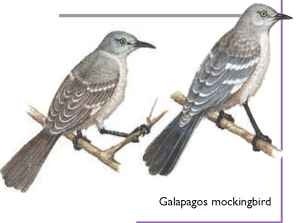
Northern mockingbird
| VITAL | |
| STATISTICS | |
| Weight | 1.5-2 oz. |
| Length | 9-11″ |
| Wingspan | 13-15″ |
| Breeding Season | March-August |
| Number of Eggs | 3-6, usually 4-5 |
| Incubation Period | 12-14 days |
| Fledging Period | 10-12 days |
| Breeding Interval | 2-3 broods per season |
| Typical Diet | Berries, seeds and insects |
| Lifespan | In captivity, up to 15.5 years; in the wild, about 12 years |
RELATED SPECIES
• A member of the family Mimidae, the northern mockingbird joins about I 13 other species of mockingbird in this group. The blue and white mockingbird, Melanotis I hypoleucos, is a vibrant, colorful contrast to the typical brown or gray of most mockingbirds. Approximately 17 species of catbirds and tremblers are relatives included in the Mimidae family of singers and mimics.
